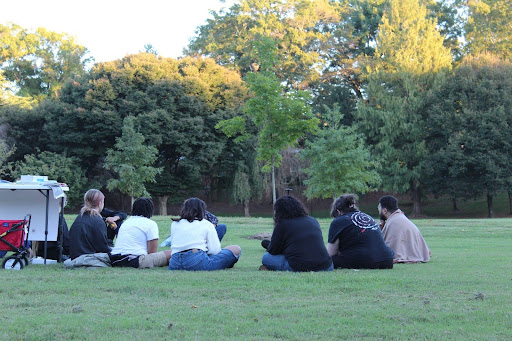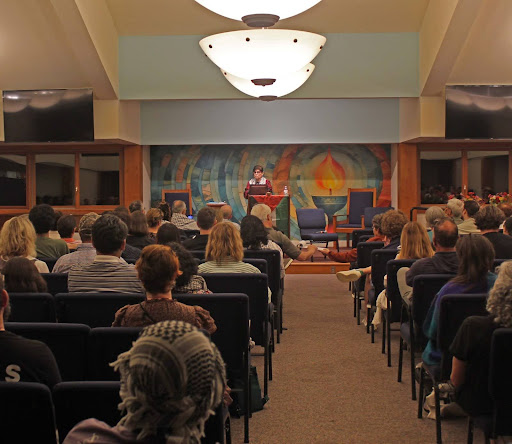This past weekend, three of the most influential scientists in their respective fields came together with Wake Forest faculty, students and biologists from five nearby states to learn from one another over a two-day period.
The Perspectives in Biology Symposium has been a yearly tradition at Wake Forest for the past 34 years. It serves primarily to connect biologists from surrounding states, many of them teaching at non-research-oriented institutions, with one another and with world-class speakers in a casual environment at an affordable rate. In that time, faculty from over 100 schools have attended, and for many event regulars it has become a homecoming of sorts to see old friends while learning new perspectives that can be brought back to their own institutions.
Yadvinder Malhi, professor of ecosystem science at the University of Oxford; Nicole Dubilier, professor for microbial symbiosis at the University of Bremen and director at the Max Planck Institute for Marine Microbiology; and Paul Turner, professor of ecology and evolutionary biology at Yale University each presented two lectures over the two days, the first a more general overview of their research and the second a more detailed presentation exploring a particular technique.
Dubilier began the symposium with her opening lecture “The Art of Harnessing Dark Energy: Symbioses Between Marine Invertebrates and Chemosynthetic Bacteria.” She detailed her research into understanding some of the most difficult ecosystems to explore: those found around geothermal vents, in complete darkness, miles below the surface of the ocean.
In these ecosystems, where zero sunlight means zero photosynthesis and zero plants, organisms rely instead on chemical compounds released from within the earth to sustain themselves. She reminded us that we take knowledge of these ecosystems for granted today, but that they were completely unknown and even considered impossible to exist until just over 40 years ago.
“These ecosystems,” she said, “were the last major discovery on earth that we knew nothing about.”
Dubilier continued on to explain that, despite their apparent remoteness, these deep-sea ecosystems have a cumulative biomass rivaling that of a tropical rainforest, meaning that developing a better understanding of how they are able create energy and thrive is not insignificant.
Shifting from alien biomes deep beneath the sea to the ecosystems that exists within our own bodies, Paul Turner’s research focuses on viruses and their ability to evolve and adapt to changes around them.
His talks focused on how his lab tests the “evolution-in-action” of viruses in controlled lab settings in order to compare the results to theoretical predictions of how scientists believe evolution should work. This allows his lab to probe at foundational questions related not only to virus prevention in humans, but also to harnessing virus evolution to create new ways that we might attack cancer or increasingly important antibiotic-resistant infections.
The keynote of the event, though, came on Friday night when Malhi delivered his presentation, entitled “The Metabolism of Planet Earth.” He reframed the global climate conversation by first illustrating just how dynamic natural ecosystem metabolism is over time and then equating humanity’s input throughout our cultural development.
One of his most striking models displayed a forest’s carbon input/output over the period of 24 hours. Trees, like all living organisms, constantly produce CO2 as a product of metabolism. Malhi’s data illustrated how trees function as carbon sinks during daylight hours due to photosynthesis, but in the absence of light or in months without leaves, they exhale CO2. Repeating this daily cycle year after year showed what Malhi described as “the breath of an ecosystem.”
He then went on to equate human metabolism over time to this natural energy demand. Each human, he explained, is constantly requiring about the same amount of energy as it takes to power two traditional light bulbs. With that simple understanding, he walked the audience through mathematical models demonstrating exactly when in human history our “industrial metabolism” of farming and factories overtook our “biological metabolism.”
Malhi then plotted a graph showing different organisms and their metabolic outputs. A straight increasing line connected small animals, like mice, which require very little energy, to the largest animals, like elephants, which require much more. Humans at different points in our history were then plotted over this line.
“Hunter-gatherers only output the energy of those two lightbulbs,” Malhi explained. “But with the development of agriculture, even before the industrial revolution each human was outputting the energy equivalent of a rhino.”
Malhi paused, then continued, “Based on this trendline, today, each human is the energy equivalent of a 15-ton primate.”
Malhi’s extensive work in tropical biosystems closely aligns with work done by Wake Forest professor and PIB coordinator Miles Silman.
Regarding Wake Forest’s ability to continually draw in world-leading scientists, Silman said, “Really, it’s indicative of the level of researchers we have here at Wake Forest. These scientists are leaders in science, but they are also our peers.”
He added, “It also shows something about the altruism in the scientific community when you bring together people who want to learn from each other.”
Dubilier, when asked about PIB, said, “Its wonderful what Wake Forest achieves with this. I don’t know of another symposium like it.”








